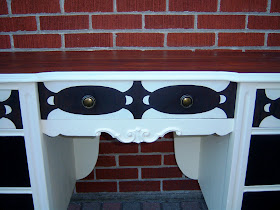In our new place, we have a large room at the back of the house that has two banks of picture windows. It's a bright room and perfect for a large table - but I wasn't willing to pay $1,000+ for an 8 foot harvest table! One day...
Until then, I found a blog post (which I also pinned to my "I'd Make This" board on Pinterest) where Loraine had made her own table out of pine boards and recycled table legs. I thought it was fantastic and sounded straightforward - which is key since I'm not a total whiz with power tools (yet!).
I was pushed for time because we had guests coming for lunch, so I botched the staining-sealing-finishing step and will need to re-epoxy the top of the table, but otherwise I'm pleased with the results. Eventually I will replace the light, 1" boards with sturdier 2" boards, but for now it will serve it's purpose: an attractive, affordable, space-conscious, and functional table for our 'blue room!'
It took me a while to find the table legs I was searching for. I finally found a table with the 'right' kind of attachments - braces rather than a full skirt - along with 4 chairs for $50. I scooped it up and set about the new project.
Forget sanding - so messy and time-consuming! - I have been using homemade chalk paint on all my furniture since I first used it on the dresser below.
I fell in love with the recipe, it's just so cheap, so easy and virtually foolproof that I can't stop using it!
I don't bother with expensive high adhesion paints for glossy surfaces (like Zinsser BIN paint, which is great, too, but at $30-$40 a gallon, it's not a bargain).
There are many blogs online that do a fantastic job of writing tutorials for making your own chalk paint. I use the following:
1 part Plaster of Paris
3 parts latex paint (I have found that the 'Painter's Touch' high gloss paints do not work well)
Water
I mix the water and Plaster of Paris together to form a paste about the consistency of thick cream. Stir well and until smooth. I mix in the latex paint and then add more water until it is paint-like consistency - it will be a bit thicker than usual. This paint dries ubber fast which is a plus, and you can do two coats in few hours. Sometimes I like to sand after 2 coats and then add a final coat of straight latex paint overtop before I wax it.
I use fine grit wet/dry sanding sponges and lightly sand with some water (often I spritz with a spray bottle full of water as I go). You will find the chalk paint sands easily so it's great for distressing or antiquing if that's the look you're going for. If not, throw a coat of pure latex overtop and then wax without sanding. The texture of the finished coat is a bit rougher, but I'm partial to it - test it out yourself, it may not be for everyone!
After priming the chairs and table legs, I painted them with high gloss black (because that's what I had on hand). If I hadn't had black paint in the 'shop I would have bought a satin or matte finish and waxed overtop.
 I had brace boards cut to size at Home Depot as well, and simply screwed these into the main boards to keep everything together. I stained the table with a MinWax stain in a colour similar to the chairs and then I sealed it with some 2-part epoxy - I use EasyCast (not it's intended purpose, it's supposed to be used for making resin jewellery or art...but whatever!). Unfortunately, because I was rushing I didn't let the stain dry for long enough and the epoxy resisted against it - so I had to scrape it down and I'll have to re-epoxy at a later date (aka. when I buy more!). Lesson learned!
I had brace boards cut to size at Home Depot as well, and simply screwed these into the main boards to keep everything together. I stained the table with a MinWax stain in a colour similar to the chairs and then I sealed it with some 2-part epoxy - I use EasyCast (not it's intended purpose, it's supposed to be used for making resin jewellery or art...but whatever!). Unfortunately, because I was rushing I didn't let the stain dry for long enough and the epoxy resisted against it - so I had to scrape it down and I'll have to re-epoxy at a later date (aka. when I buy more!). Lesson learned!
All-in-all I'm pleased with the effect and it will give us a way to 'entertain' without taking up an entire room.
I'm sharing this blog post at The Shabby Nest - check it out and all the other inspiring ideas and DIY projects!













































